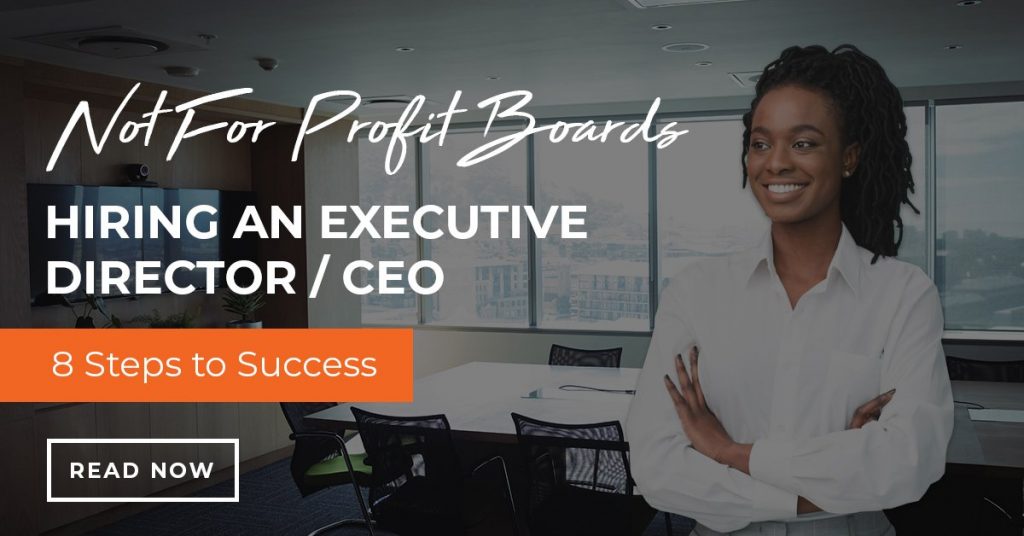Not-For-Profit Boards: Hiring an Executive Director / CEO
There are numerous reasons that a not-for-profit organization could be looking to hire an Executive Director or CEO.
The current leader may have resigned from the role, it could be time for a change of direction for the organization, or succession planning in light of an upcoming retirement. Often the incumbent has outgrown the role, or the role has outgrown them. Either way, it is arguably the most important decision the Board, as the governing body of the organization, will have to make. As a Board you will depend on the leader of the organization to drive all of the day-to-day operational decisions that enable the not-for-profit to accomplish its mission.
How do you, as a Board, ensure an effective Executive Director / CEO hiring process and secure the right person for the role and future success of the organization?

Step 1 – Creating Board Alignment
The key to success in any hiring process is to ensure all the decision makers are aligned. As a group you will need to understand the mission of the organization and what you are looking to achieve. The future vision and mandate needs to be discussed and considered, even beyond the next 3-5 years. Analyzing the needs of the not-for-profit organization and having a strong grasp of its strengths and weaknesses will greatly increase your chance of success. Taking this knowledge and creating objectives and your expectations for the new incoming Executive Director / CEO will help you identify the skills, abilities, knowledge, experience and characteristics you are looking for in this hire.
It is important to set a clear budget that safeguards and protects the organization financially but also provides you scope to find the right Executive Director / CEO candidate for the role. From this you will be able to create a baseline to assess potential candidates.
Step 2 – Creating a plan for the search
Boards can often encompass a large group of 15-20 people, which is far too many for a search process. As a group, you need to identify a smaller selection committee who will take an active part in the search process and make a final recommendation to the wider Board once a leading candidate has been selected.
Who should be part of the selection committee? The recruitment process will take time so it’s important to identify members that can commit to the full recruitment process and those that have skills that can complement one another in the selection process. The Chair often has the final say if there is a conflicting decision, so their participation is actively encouraged.
Step 3 – Hiring an Executive Search Firm
A search firm who is experienced in this type of recruitment can complement a Board and support them in the hiring decision for your next Executive Director / CEO. Extensive stakeholder consultations with the executive search firm will help the selection committee identify the key criteria for the Executive Director / CEO and how this hire can help support the mission of the organization. There will always be a list of skills and experience required, and a discussion can help identify what are the must haves versus the nice to haves and how these tie into success for the organization. It is important to identify what success looks like for the new Executive Director / CEO and develop a clear value proposition as to why someone will want to consider this opportunity. Set a clear road map for the search with expectations and timelines.
Step 4 – Attracting Executive Director / CEO Candidates
How do you ensure that you are identifying and attracting the right talent for this role? Do not rely exclusively on applicants to a job advert. If you do you limit the organization to those individuals that are actively looking for work, this number is typically less than 20% of the potential talent pool.
You have to think broadly and beyond people you might know for the role. Talent mapping will provide greater insight into where you might find someone with the skills for the role and where your future leader might currently be employed.
It is now time to think like a marketer. Understand your employee value proposition and be able to articulate this to candidates – this will be your differentiator. Give them a compelling reason to have a conversation with you, think about what’s in it for them.
Step 5 – Ensuring diversity in the search process
A key aspect in your Executive Director / CEO search is to ensure diversity exists in your hiring process. Identify and remove potential biases in the sourcing, screening and shortlisting of candidates. In order to ensure diversity in hiring, you need to analyze your data and understand where you are today. Review any documentation you will be sending to potential candidates. Studies have found that the language you use can help attract or turn off diverse candidates. Understand your search criteria as many of the usual criteria for screening such as their prior company, their school, or their personal connection, often decrease the diversity of the candidate pipeline. Take regular stock of the pool – notice early if you lack diversity, do not wait until you get to the shortlist to make adjustments so you have the strongest and most diverse pool of candidates possible. Ensure that the executive search firm you are working with has a diversity policy in place and has a proven track record of sourcing a diverse talent pool.
Step 6 – Assessing Executive Director / CEO Candidates
Interviews are the most common method of assessing candidates for a new role. It is important to prepare for an interview ahead of time so that you can assess candidates properly. Prepare an interview schedule that provides time for discussion on career history, time for predetermined questions, discussion of your organization and the role, and questions from the Executive Director / CEO candidates.
When considering questions to ask, think about the attributes you identified as essential requirements. For example – must be able to manage a team – Question – Tell me about a time you managed a team, how did you ensure this was a positive and beneficial relationship for you, the team and the not-for-profit organization?
Make sure that you allow enough time for the interview, you will likely need an average of 90 minutes for each interview. Stick to the agenda, this will be important to ensure you are evaluating each candidate fairly and objectively. Interviews will naturally take their own course – ensure that you have certain questions you will ask each candidate and evaluate their answers against one another.
If you are interviewing in-person, think about the logistics, you do not want potential candidates meeting in the lobby. Given our current climate, we are often interviewing via video conference, this can be challenging for a panel style interview. Prepare ahead of time who will take which questions, ideally everyone will actively participate. I would highly recommend where possible, still conducting the final interview in-person with the right precautions and measures to protect everyone.
Step 7 – Making an Offer to an Executive Director / CEO Candidate
The selection committee will need to come to a consensus on who they would like to hire and make this recommendation to the entire Board. Ensure that you can justify your decision to the Board and demonstrate the fair and equitable process you went through to identify the candidate. Understand before you extend an offer what the compensation expectations of the Executive Director / CEO candidate are. Think of the compensation package holistically, it should not be focused on base salary alone. Things that are typically important to be aware of are the candidates base salary, any bonus expectations, what they expect in terms of benefits, vacation allowance, sick days, pension or RRSP, equipment provided, location, flexibility, hours of work – these are all part of the offer discussion.
Be prepared to negotiate, especially in the current climate and understand the risks from a potential counter offer from their current employer.
Step 8 – Post-Placement Integration for an Executive Director / CEO Candidate
How do you ensure the success of a new leader?
A successful onboarding process will greatly increase the chance of a positive hiring outcome. You should start the onboarding process before the new Executive Director / CEO starts. It should be done shortly after you have identified the right candidate and they have accepted the offer.
Have your new Executive Director / CEO meet the team and allow time for casual conversations ahead of time. Designate one or two Board members who will be accessible before they start and provide the incoming Executive Director / CEO any additional information that will help set them up for success on day 1.
Be open and upfront with them, if there are challenges they will face when they start, make them aware ahead of time. Once they have started set clear and achievable goals, make sure they know what success in the role means and how they will be measured against it.
Set time aside in the first 3 months to complete regular touchpoints that are focused on assessing their success. Give your Executive Director / CEO time to acclimatize to the role – integration does not happen overnight. Make sure they have a support system either from the Board, or from an external coach or mentor. Provide feedback on what is working and where there is room for improvement. Communication is key.

